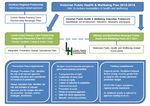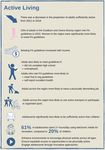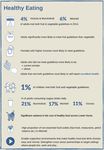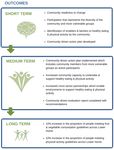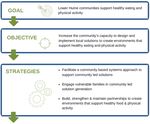STRATEGIC PREVENTION PLAN - Lower Hume ...
←
→
Page content transcription
If your browser does not render page correctly, please read the page content below
STRATEGIC
PREVENTION PLAN
2017-2021 Lower Hume Primary Care Partnership
This strategic prevention plan outlines the next four year commitment to Healthy
Eating and Physical Activity by the members of the Lower Hume Primary Care
Partnership Integrated Health Promotion Collaborative. It outlines the rationale
and the chosen Goal, Objectives and Strategies the group will implement to
create behavior change within Lower Hume communities.Strategic Prevention Plan2017-2021
Strategic Prevention Plan
L O W E R H U M E P R I M A RY C A R E PA R T N E R S H I P
Contents
EXECUTIVE SUMMARY ................................................................................................ 2
1.0 CONTEXT ................................................................................................................ 3
Guiding Plans ......................................................................................................................................... 3
Introduction and Rationale of our Priority.................................................................................... 3
Partners .................................................................................................................................................... 4
Healthy Eating and Active Living Statistics ................................................................................ 4
Key contributing factors to our Plan .............................................................................................. 8
Learnings from last 4 years of Healthy Eating priority ........................................................ 8
Alignment with State and Local Government Plans ............................................................. 8
2.0 THE NEXT 4 YEARS .............................................................................................. 11
Goals and Objective ......................................................................................................................... 11
Priority Population ............................................................................................................................. 11
RESPOND Grant ............................................................................................................................... 11
PROGRAM LOGIC ....................................................................................................... 13
APPENDIX ................................................................................................................... 14
Appendix 1 State Government .................................................................................................. 14
Appendix 2 Data Comparisons ................................................................................................. 15
REFERENCES ............................................................................................................. 16
Page 1Strategic Prevention Plan EXECUTIVE SUMMARY For the next four years (2017-2021), the Lower Hume Primary Care Partnership Integrated Health Promotion Collaborative will continue with the priority of Healthy Eating and expand to include Physical Activity; aligning with one of the priorities of the Victorian Public Health and Wellbeing Plan 2015-19 (Healthier Eating and Active Living). This is in accordance with the Advice for public health and wellbeing planning in Victoria: planning cycle 2017-21 (April 2017) and the Prevention Plan requirements of the DHHS East Division - Ovens Murray and Goulburn Place Based Prevention Strategy. The continued focus on Healthy Eating will enhance the likelihood of delivering long term outcomes for our local communities. Our goal is ‘Lower Hume communities support healthy eating and physical activity.’ Our objective is: Increase the community’s capacity to design and implement local solutions to create environments that support healthy eating and physical activity choices. The Lower Hume trends in regards to the consumption of fruit and vegetables, sugar sweetened beverages and discretionary food consumption, in addition to low rates of physical activity and high prevalence of overweight and obesity support the need for a focus on Healthier Eating and Physical Activity in the catchment. In line with the Place Based primary prevention principles we will continue to align with both Municipal Public Health and Wellbeing Plans of Murrindindi and Mitchell Shire Councils and aim to have mutually reinforcing activities with the local organisations and community groups that are involved in healthy eating and physical activity. Health equity is a continued focus at a national, state and local level and requires a range of universal approaches that not only create settings and environments supportive of healthy eating and physical activity, but also deliberately target particular hard to reach populations. Both of these approaches will be considered by targeting families using systems thinking and action research models. We will continue to build on the collaborative‘s achievements from the last four years in partnership with funded and non-funded partners, local government and community organisations. We have sought to capitalize on the successes, learn from the challenges, and consider these in the development of our future objectives, strategies and actions. In particular, the current plan will aim to engage the whole community in the identification of enablers and barriers to healthy eating and physical activity, how these factors interact within the complex community settings or ―system‖ and develop community led solutions that promote healthy eating and physical activity behaviours. Page 2
Strategic Prevention Plan2017-2021
1.0 CONTEXT
Guiding Plans
Introduction and Rationale of our Priority
For the past 4 years the Lower Hume Integrated Health Promotion Collaborative have fulfilled the
requirements of the Hume Region Health Promotion strategy, with a region wide priority of healthy
eating and sub-regional priority of Prevention of harm from Alcohol. We have operated as a
Collaborative of funded and non-funded partners to achieve a range of Health Promotion successes
and outcomes that we will build on over the next 4 years.
The 4 year Hume Region strategy was evaluated and one of the key recommendations was to continue
to build on the success of our collaborative work and commitment to Healthy Eating. This year the
Ovens Murray and Goulburn Regions (previously Hume Region) will continue with the priority of
Healthy Eating and (include) Physical Activity; a priority direct from the Victorian Public Health &
Wellbeing Plan 2015-2019. Lower Hume has chosen not to have a second sub-regional priority.
Our work will be guided by the Victorian Public Health and Wellbeing Outcomes Framework to
guide our outcomes, measures and targets. We will be guided specifically by Domain 1:
Victorians are healthy and well, Outcome 1.3: Victorians act to protect and promote health,
Indicators: 1.3.1 to increase healthy eating and active living, and 1.3.2 reduce overweight and
obesity.
Page 3Strategic Prevention Plan We will also continue to closely align with both Mitchell and Murrindindi Shire‘s Municipal Public Health and Wellbeing Plans, cross referencing with their Annual Action Plans which were both informed by extensive community consultation. Both Councils are represented within our collaborative which we have found strengthens the collaborative efforts in the local communities. The Goulburn Regional Partnerships will also inform our work, with their extensive community consultation; Health is one of their identified priorities and will inform our place based approach. The Lower Hume Primary Care Partnership Strategic Plan has been extended and is in a bridging year until 2018 when the next 2 year plan will be developed which will include strategies to support the implementation of the Prevention Plan. Partners Alexandra District Health Lower Hume Aboriginal Health and Wellbeing Program Officer Mitchell Shire Council Murrindindi Shire Council Nexus Primary Health Seymour Health Valley Sport Yea & District Memorial Hospital Health y Eating and Active Living Statistics The Lower Hume Primary Care Partnership Population Health and Wellbeing Profile provides local statistics within each of the domains of the Victorian Public Health and Wellbeing Outcomes framework. The following is a summary of some of the data from the Healthy Eating and Active Living Domain, and more specifically the two indicators; to increase healthy eating and active living, and reduce overweight and obesity. There are comparative tables, with State, Regional, Mitchell and Murrindindi Local Government areas for both the healthy eating and physical activity indicators in the Appendix. The summary and info graph on the following pages captures key statistics for the 2 indicators and further information can be found in the full report on the PCP website www.lhpcp.org.au Page 4
Strategic Prevention Plan2017-2021
Summary of healthy eating and active living statistics across Lower Hume
Less than 10% of adults meet the fruit and vegetable guidelines in Mitchell and Murrindindi, and
across Victoria. In both Lower Hume and Victoria, adults consume less serves of fruit and vegetables
per day than is recommended. Although a significantly higher proportion of adults (and children) across
all areas met fruit guidelines compared to vegetable guidelines. The statistics are even less for children
in the Goulburn Region and Victoria.
Local parent surveys identified the same top three barriers to their children consuming a variety of
nutritious foods at baseline (2013-14) and at more recent data collection (2017). These were fussy
eating (41%), cost (29%) and time/energy (21%).
In 2014 21% of adults in Murrindindi consumed sugar sweetened beverages daily, which was almost
two times higher than the state average. Adults in Mitchell Shire also remained more likely to consume
sugar sweetened beverages daily than the Victorian average. In 2017 36% of primary school children
surveyed within Lower Hume drank sugar sweetened beverages on the previous day, which was a
decrease from 2013/14.
A significantly higher proportion of adults in Murrindindi Shire, compared to the state average, had run
out of food in the previous twelve months and couldn‘t afford to buy more in 2014; whilst Mitchell was
below state average. The cost of a healthy food basket in Lower Hume increased over six years for all
family types. On average one third of a typical family‘s (2 adults and 2 children) welfare payment was
spent on a healthy food basket in 2016. The variance of the cost of healthy food across Lower Hume
was significant with consumers paying up to 30% more for the same basket of food depending on
where they shopped. Comparison with other regional areas throughout Victoria identified that overall
the cost of a HFB in Mitchell shire in 2016 was below average, whilst Murrindindi was similar to other
regional areas.
63% of infants across Victoria were fully breastfed to three months of age in 2014/15, which was
similar across Mitchell and Murrindindi Shires.
A significant decrease in the proportion of adults completing the recommended minimum amount of
physical activity occurred across Victoria from 2011 to 2014. A slight increase was reported in the
2015 Victorian Population Health Survey (VPHS) with 47% of Victorian adults and 53% of adults in the
Goulburn and Ovens Murray region meeting physical activity guidelines. The 2015 VPHS also found
that the proportion of men and women who undertook adequate physical activity significantly increased
with increasing total annual household income. In 2014 adolescents were significantly less likely than
children to be sufficiently active.
Adults living in Lower Hume were less likely to use active transport for travel or participate in
organised sport when compared to state average. The proportion of adults sitting for more than eight
hours on a typical weekday was significantly less across Mitchell Shire and similar to state average of
24% in Murrindindi Shire. Across Victoria younger adults were significantly more likely to sit for more
than eight hours on a weekend day.
Adolescents across Victoria were significantly more likely to spend more than two hours per day using
electronic media for recreation compared to children. A slightly higher proportion of children in the
Goulburn Region (20%) and a similar proportion of adolescents (61%) reported spending more than
two hours per day using electronic media for recreation compared to state average.
Both Mitchell and Murrindindi Shires had significantly higher proportions of adults who were overweight
or obese in 2014 when compared to state average. Adults across Lower Hume were also more likely to
have a waist measurement above the recommended healthy range. The proportion of children and
adolescents who were overweight or obese was similar to state average across Lower Hume at 28%.
Page 5Strategic Prevention Plan
Pictorial representation of selected Healthy Eating data from Lower Hume Population Health Report
Page 6Strategic Prevention Plan2017-2021
Pictorial representation of selected Active Living data from Lower Hume Population Health Report
Page 7Strategic Prevention Plan
Key contributing factors to our Plan
Learnings from last 4 years of Healthy Eating priority
The learnings, barriers and recommendations from the Healthy Eating priority within our Integrated
Health Promotion Plan were identified and below are those that we will incorporate into the 2017-21
strategic and annual action plans.
- Collaboration between organisations, community groups and individuals was one of the key
strengths to the successful outcomes in the last four years. We intend to build on this using a
systems thinking approach, engaging even more of the system to own both the issue and
solutions. We found that it is important to ensure communities‘ or settings have a readiness to
change, engage, implement and sustain interventions.
- The place based approach as recommended in the Ottawa Charter for Health Promotion
acknowledges that settings should be targeted to achieve healthfulness in everyday life.
Impacting individualised settings within Lower Hume allows for differences in the community by
recognising that they are not comprised of a homogenous group of people. These people have
unique needs and characteristics. Each region has its own demographic and social context
which will influence the community‘s level of engagement, readiness to change as well as what
a workable solution may be to that community.
- The evaluation of the 2013-17 LHPCP IHP Plan supports the premise that evidenced based
interventions can be challenging to implement when working with areas of the community, if
they are not ready to engage or change. The experience from the implementation of the 2013-
17 plan was that community identified solutions, such as Triangle Food Op-Shop, Incredible
Edible Yea, and community gardens within Mitchell Shire (which used the Healthy Food
Connect evidence based framework) had greater community support, engagement and
sustainability than predefined programs.
- The Achievement Program, is endorsed and developed from an evidence based prevention
model that we chose to implement in school and early years settings, with a structured and
predetermined process to follow. The strength of the Achievement Program framework is that it
works with the whole environment to shift the culture and achieve the goals (for example in a
school, the staff, students, leadership, parents, community, policies, processes, curriculum etc
are all considered in the intervention). There was fair to good success with schools signing up
for the Achievement Program, however not a lot of success in the settings being awarded this.
This is likely due to numerous factors, and our observation supported by literature, is that
―successful prevention programs are owned by the targeted community itself‖ (Edwards et al
2000).
In response to these key learnings (and as referred to in objective 1) the current plan will use a
community led approach (employing systems thinking and collective impact theories and
methodologies) to foster community ownership of the issue and solutions within community settings.
Those who live within the catchment communities will be active participants in identifying both the
contributing factors and solutions to unhealthy eating and inactivity behaviors using an evidence based
methodology. Community led research and solution planning is key to fostering sustainable change.
Alignment with State and Local Government Plans
As stated our priority is aligned with the Victorian Public health and Wellbeing Plan 2015-19 priority of
Healthier Eating and Active Living. Our strategies and actions will consider the Plan‘s Strategic
Directions (see Appendix 3). Our outcomes, indicators, targets and measures also align with the
Victorian Public Health and Wellbeing Outcomes Framework.
Page 8Strategic Prevention Plan2017-2021
Having Mitchell and Murrindindi Shire Council Officers represented on our Collaborative supports
alignment with both of the Shire‘s Municipal Public Health and Wellbeing Plans (MPHWP). Our funded
organisations have been involved in the development of both Council plans. Whilst worded quite
differently, both Municipal Health and Wellbeing Plans have an area of focus based around achieving
increased healthy eating and physical activity. Both plans intend of doing this by using collaborative
partnerships for collective impact within local community settings that impact where people learn, work,
play and live.
Many of the social determinants of health, particularly those that affect people eating healthy food and
being active are also addressed in the Municipal Public Health and Wellbeing plans. Whilst some of
those may be outside of the scope of our strategy and limited resources, we acknowledge their
strategies that focus on improving education, work and employment, transport, social connectedness
etc all will contribute to healthier and more active communities.
The Mitchell Shire Council Municipal Health and Wellbeing Plan priority of Healthy and Vibrant
Communities, to improve health, wellbeing and mental health through education and awareness and
decrease the use of tobacco aligns with our own priority. The two relevant strategies of the priority;
Support and promote initiatives that contribute to healthy eating and access to affordable nutritious
food; and in partnerships with key stakeholders, agencies and networks, promote opportunities for
increased physical activity, are where we have collaborative alignment. Their measures also coincide
with our own (the same as the state level)
Decrease rates of obesity.
Increased consumption of fruit and veg intake.
Decreased food insecurity rates.
Increase rates of breastfeeding.
Increase participation in physical activity, recreation and leisure.
The Murrindindi Shire Municipal Public Health and Wellbeing Plan has key strategic objectives
where we will have collaborative opportunities; Our People – Together we will celebrate and encourage
diverse, caring and connected communities and, Our Place - We will maintain and enhance places to
be attractive and livable, in balance with our natural environment. The relevant draft strategies we will
specifically align with are:
Work with our partner agencies to ensure people of all ages can access the health and community
services they need
Work with community and groups to connect, collaborate and plan for our future
Support recreation opportunities for our residents and visitors that encourage participation and
community connections.
Page 9Strategic Prevention Plan
Lower Hume Demographic Overview
TABLE 1: DEMOGRAPHIC SNAPSHOT, 2016
Mitchell Murrindindi
Population 40,918 13,732
Square km² 2,862 3,880
Top 3 employment Construction Construction
industries
Health care & social assistance Health care & social assistance
Public administration & safety Agriculture,forestry & fishing
Unemployment rate 5.7% 5.1%
Median age 37 48
FIGURE 1: SEIFA INDEX OF RELATIVE SOCIO-ECONOMIC DISADVANTAGE (IRSD) MAP, 2011
Page 10Strategic Prevention Plan2017-2021
2.0 THE NEXT 4 YEARS
Goals and Objective
Goal: ‗Lower Hume communities support healthy eating and physical activity.‘
Objective 1: Increase the community‘s capacity to design and implement local solutions to create
environments that support healthy eating and physical activity choices.
Rationale:
- Deakin University‘s Global Obesity Centre identifies that successful approaches to obesity
prevention have involved ―building community capacity to apply systems thinking‖ (Deakin
University 2016).
- Systems thinking acknowledges that factors that contribute to poor dietary intake for example,
are not independent of each other and nor do they occur one at a time. It attempts to identify the
complex relationships that contributing factors have and which of these relationships are the
most important. A child‘s consumption of vegetables for example can be influenced by parental
food knowledge, cooking skills and ability to manage their child‘s fussy eating. Parents learning
new ways to cook vegetables may not be utilised if they don‘t have the skills to manage their
child‘s fussy eating, while conversely parents‘ new skills to overcome their child‘s fussy eating
may be hindered if they don‘t have the skill, confidence and knowledge to prepare vegetables.
- Advantages of community capacity building include better reach of target population, better use
of resources, an increased competence and commitment for health change and action and a
greater ability of communities to respond to emerging health issues (Liberato SC et al 2011).
Priority Population
Healthy Eating and Physical Activity
Families (focus on equity and vulnerable families).
The Collaborative decided that it was important to sustain and develop our work with children due to the
evidence in regards to the importance of the early years in determining adult health, particularly in
relation to obesity (Maffeis et al, 2016). Further, extending the target population to parents/caregivers
(families) was considered important due to their fundamental roles in the shaping of child behaviours
and providing the conditions for healthy child development (Graham & Power, 2004). Tackling
inequities (vulnerable groups) in the early years through work with families is also in line with the PCP
guiding principles to action which emphasises ‗tackling health inequities‘ and taking a ‗person and
family centred‘ approach (Department of Health, 2013), and is also supported by the Public health and
wellbeing planning advice 2017-2021.
RESPOND Grant
RESPOND (Reflexive Evidence and Systems interventions to Prevent Obesity and Non-communicable
Disease)
In 2017 the Ovens Murray and Goulburn region PCP‘s, with Department of Health and Human
Services, VicHealth and the World Health Organisation Collaborating Centre for Obesity Prevention at
Deakin University applied to the National Health and Medical Research Council (NHMRC) for the
RESPOND grant. The project seeks to implement a major partnership systems thinking project to
address childhood obesity across all 12 LGAs in the Region. The project will include initial and
subsequent data collection among school age children (base line and follow-ups) and then assist in the
facilitation and development of a community based response to address the issue of childhood obesity.
We find out in February 2018 if we are successful.
Page 11Strategic Prevention Plan If the RESPOND grant is successful the collaborative will have access to extensive data collection to measure our impact and significant training and support to implement systems across the catchment. If the grant is not successful, the collaborative will seek an extension of the school based children‘s healthy eating surveys to specifically measure the consumption of fruit, vegetables and discretionary foods. In addition, support will be sought from both Deakin University researchers and other OMG PCP Health Promotion teams that have already undertaken a similar systems thinking approach to obesity prevention. Page 12
Strategic Prevention Plan2017-2021
PROGRAM LOGIC
Page 13Strategic Prevention Plan
APPENDIX
Appendix 1 State Government
Victorian Public Health and Wellbeing Plan 2015-2019
Priority - Healthier Eating and Active Living
Strategic Directions
Promote consumption of healthy, sustainable and safe food consistent with the Australian
dietary guidelines.
Support healthy food choices to be the easier choices for all Victorians by working across the
entire food system.
Encourage and support people to be as physically active as often as possible through their
lives. Strategies may include active transport (such as walking or cycling to work),
neighborhood design that promotes activity and social connectedness and participation in
sport and recreation
Encourage interaction with nature in Victoria‘s parks and open spaces.
Victorian Public Health and Wellbeing Outcomes framework
Outcome – Victorians act to protect and promote health.
Indicator – increase healthy eating and active living.
Targets – 5% decrease in prevalence of overweight and obesity in adult (and children) by 2025 from
2011-2 baseline. Measures – proportion of adults, adolescents and children who consume sufficient
fruit and veg/consume sugar-sweetened beverages daily/are overweight and obese, - mean serves
of fruit and veg for adults, adolescents and children, - discretionary food consumption of adults,
adolescents and children, - proportion of infants exclusively breastfed to three months of age.
Outcome Victorians belong to resilient and livable communities.
Indicator – increase neighbourhood livability.
Page 14Strategic Prevention Plan2017-2021
Appendix 2 Data Comparisons
TABLE 82: SUMMARY OF HEALTHY EATING INDICATORS, 2014
Goulburn
& Ovens
Mitchell Murrindindi Victoria
Murray
region
Proportion of adults that met both fruit and
6%* 4% 6%^^ 4%^^
vegetable guidelines
Proportion of children (4-12 years old) that met
** ** 1%* 3%
both fruit and vegetable guidelines
Proportion of young people (in years 5, 8 & 11)
** ** 14% 11%
that met both fruit and vegetable guidelines
Proportion of adults who consume sugar
17% 21% 15% 11%
sweetened beverages daily
Proportion of people who ran out of food and
3%* 12.8%* 6% 4%
couldn‘t afford to buy more
Proportion of infants exclusively breastfed to 3
61% 62% ** 63%
months of age
Source: Victorian Population Health Survey, 2014 and 2015. Victorian Child and Adolescent Monitoring System, 2017.
*RSE between 25-50% and should be interpreted with caution. ^^2015 VPHS different sampling method used.
TABLE 92: SUMMARY OF PHYSICAL ACTIVITY INDICATORS
Adults siting
Adolescents Adults
Adults Children for 8 hours+
sufficiently participating
sufficiently sufficiently on average
physically in organised
active (2014) active (2014) work day
active (2014) sport (2015)
(2014)
Mitchell 38% ** ** 20% 15%
Murrindindi 42% ** ** 20% 21%
Goulburn 16%*
53%* 75% 28% **
region
Victoria 47* 62% 26% 29% 23%*
Indigenous **
38% 64% 25% **
Australians
Target 74% - 46% - -
Source: Victorian Population Health Survey, 2014 & 2015. Victorian Child and Adolescent Monitoring System, 2017. Vichealth Indicators
Survey 2015. *2015 VFPHS different sampling method used. **Not available.
Page 15Strategic Prevention Plan REFERENCES Allender, S., Millar, L., Hovmand, P., Bell, C., Moodie, M., Carter, R., Swinburn, B., Strugnell, C., Lowe, J., de la Haye, K. and Orellana, L., 2016. Whole of systems trial of prevention strategies for childhood obesity: WHO stops childhood obesity. International journal of environmental research and public health, 13(11), p.1143. Deakin University 2016, ‗Community Based Systems Interventions‘, Globe Obesity Centre, retrieved 31st October 2017, Department of Health, 2013. Primary Care Partnership Program Logic 2013-2017. Melbourne: State Government Victoria. Department on Health 2017. Advice for public health and wellbeing planning in Victoria: planning cycle 2017-2021. Melbourne: State Government Victoria Department on Health 2017. Victorian public health and wellbeing plan 2015-2017. Melbourne: State Government Victoria https://www2.health.vic.gov.au/about/health-strategies/public-health-wellbeing- plan Edwards RW, Jumper-Thurman P, Plested BA, Oetting ER and Swanson L, ‗Community Readiness: Research to Practice‘, Journal of Community Psychology, Vol 28, No. 3, pp 291-307, John Wiley and Sons Inc. Graham, H. and Power, C., 2004. Childhood disadvantage and adult health: a lifecourse framework. London: Health Development Agency. Liberato SC, Brimblecombe J, Ritchie J, Ferguson M & Coveney J, 2011, ‗Measuring capacity building in communities: a review of the literature‘, BMC Public Health, retrieved 27th October 2017, https://bmcpublichealth.biomedcentral.com/articles/10.1186/1471-2458-11-850 Maffeis, C., Licenziati, M.R., Vania, A., Garofalo, P., Di Mauro, G., Caroli, M., Morino, G., Siani, P. and Chiamenti, G., 2016. Childhood Obesity. In Clinical Management of Overweight and Obesity (pp. 131- 147). Springer International Publishing. Mitchell Shire Council, 2017. Mitchell Municipal Public Health and Wellbeing Plan https://engagingmitchellshire.com/municipal-public-health-and-wellbeing-plan-2017-2021 Strugnell, C., Millar, L., Churchill, A., Jacka, F., Bell, C., Malakellis, M., Swinburn, B. and Allender, S., 2016. Healthy together Victoria and childhood obesity—a methodology for measuring changes in childhood obesity in response to a community-based, whole of system cluster randomized control trial. Archives of Public Health, 74(1), p.16. Page 16
You can also read


